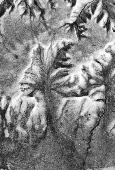Badlands Guardian facts for kids
The Badlands Guardian is a natural landform found near Medicine Hat in southeastern Alberta, Canada. When you look at it from an airplane, it looks like a human head wearing a special Indigenous headdress. The head seems to be looking towards the west.
Some people also see extra shapes that look like earphones on the figure. These "earphones" are actually a road and an oil well. These were built by people recently and will likely disappear when they are no longer used. The Badlands Guardian is much bigger than the famous faces carved into Mount Rushmore.
The head shape is a valley created by nature. It formed as wind and water slowly wore away soft, clay-rich soil. This process is called erosion.
The area around the Badlands Guardian is a dry place called the badlands. It doesn't rain often, but when it does, the rain is very strong. This strong rain, along with the wind, helps shape the soft ground. Even though it looks like a bump from above, the "head" is actually a dip in the land, like a bowl. It's a valley formed by erosion in a layer of clay. Scientists believe this natural feature is at least hundreds of years old.
Discovery of the Guardian
The Badlands Guardian was first noticed in 2005. A person named Lynn Hickox found it while exploring the area using Google Earth. Google Earth is a computer program that lets you see satellite images of places all over the world.
Naming the Feature
In 2006, a radio show called As It Happens on CBC Radio One asked people for ideas to name the landform. They received about 50 different names. From these, seven names were suggested to the Cypress County Council, which is the local government. The council decided to name it the Badlands Guardian, changing it slightly from "Guardian of the Badlands."
Worldwide Attention
The Badlands Guardian quickly became famous around the world. The Sydney Morning Herald newspaper called it a "net sensation," meaning it became very popular online. PCWorld magazine described it as a "geological marvel," which means a wonderful natural rock formation.
Canada's Global Television also reported on the Badlands Guardian. It was even listed by Time Magazine as one of the top ten amazing finds on Google Earth.
See also
 In Spanish: Badlands Guardian para niños
In Spanish: Badlands Guardian para niños


